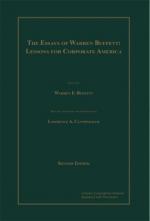
|
| Name: _________________________ | Period: ___________________ |
This test consists of 5 multiple choice questions, 5 short answer questions, and 10 short essay questions.
Multiple Choice Questions
1. LBO operators benefitted from the use of ________ to reshuffle business, risk little of their own money to gain high fees, etc.
(a) Reports.
(b) Debt.
(c) Downsizing.
(d) Meetings.
2. All acquisition considerations were paid for in ________, according to the book's information.
(a) Cash.
(b) Handshakes.
(c) Stocks.
(d) Trades.
3. Buffett and Munger did not operate a strategic plan for __________ but compare opportunities against passive investments.
(a) Buyouts.
(b) Acquisitions.
(c) Reports.
(d) Stockholders.
4. A stock _______ might attractive investors unlike their current investor group which might downgrade the quality of the shares.
(a) Sale.
(b) Selloff.
(c) Split.
(d) Option.
5. Buffett and Munger recapitalize into Class A and _____ non-voting shares to offer a lower trading price.
(a) B.
(b) D.
(c) C.
(d) E.
Short Answer Questions
1. ________ took fictional accounting actions that showed absurd accounting manipulations to let it undersell all competition to dominate the industry.
2. Accounting for the purchase of a business required allocating the ________ first to the fair value of net assets.
3. Buffett admitted that issuing ________ in mergers cost shareholders money, according to the book.
4. Buffett and Munger believed that investors should pay attention to business results, not __________.
5. Businesses must recognize present value _______ for post-retirement health benefits, according to Buffett.
Short Essay Questions
1. What were the two super contagious diseases that could spread in the investment community?
2. What happened as the result of the fictional accounting actions by US Steel?
3. What was the difference between the purchase and the pooling transaction?
4. How did Buffett avoid diluting share value to existing shareholders?
5. Despite his frustration with the GAAP, what did Buffett come to realize about accounting data?
6. What did Buffett expect to owners of stock to do when he creates a principle that earnings should be retained to the extent each retained dollar creates at least one dollar of market value for owners?
7. What did Buffett try to do in order to avoid problems with the two contagious diseases in the investment community?
8. What threatened the global competitiveness of major American industries, according to the book?
9. What did Buffett prefer in trading that allowed for more benefits to long-term owners of stock?
10. What did Buffett want to do with the Berkshire stock on the NYSE?
|
This section contains 580 words (approx. 2 pages at 300 words per page) |

|




